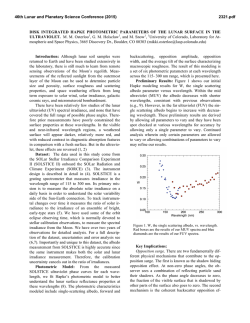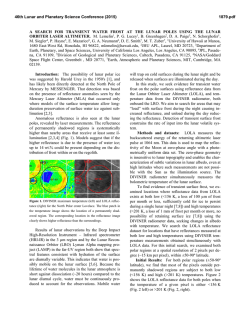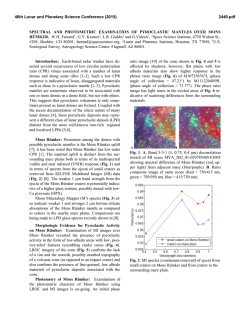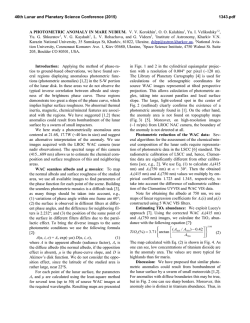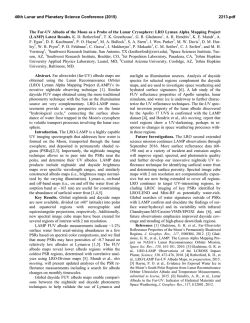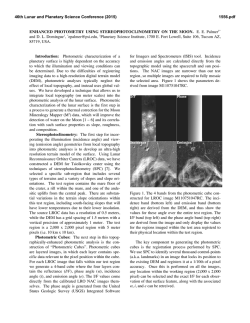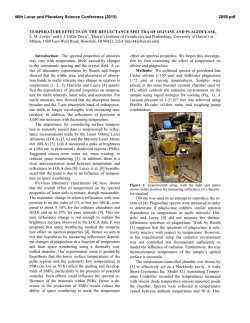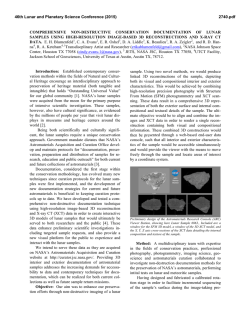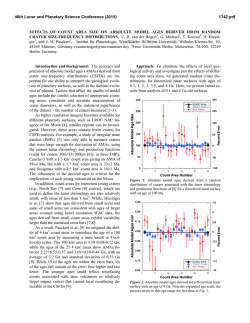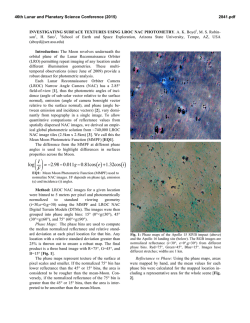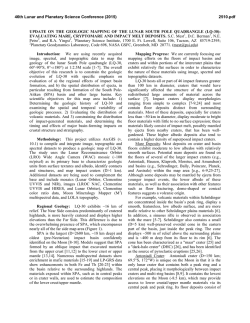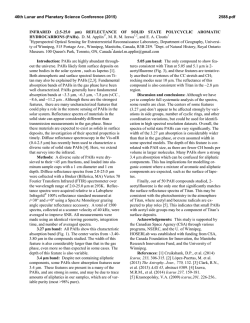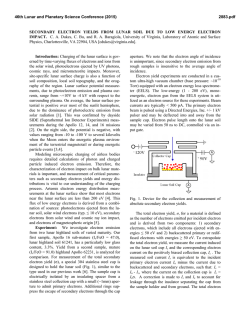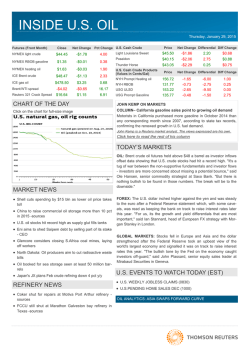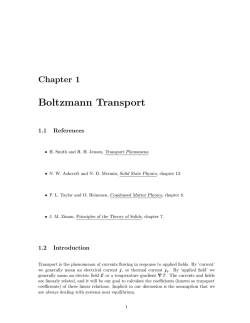
in-situ lunar phase curves extracted from imageries measured by
46th Lunar and Planetary Science Conference (2015) 2909.pdf IN-SITU LUNAR PHASE CURVES EXTRACTED FROM IMAGERIES MEASURED BY PANORAMA CAMERAS ONBOARD THE YUTU ROVER OF CHANG’E 3 MISSION. Weidong Jin1, Hao Zhang1, Ye Yuan1, Kaichang Di2, Wenhui Wan2, Bin Xu2, Bin Xue3, Yazhou Yang1, Long Xiao1, and Ziwei Wang1, 1School of Earth Sciences, China University of Geosciences, Wuhan, China ([email protected] ), 2State Key Laboratory of Remote Sensing Science, Institute of Remote Sensing and Digital Earth, Chinese Academy of Sciences, Beijing, China, 3Xi'an Institute of Optics and Precision Mechanics, Chinese Academy of Sciences, Xi’an, China. Introduction: Although the Yutu Rover suffered a premature failure shortly after its deployment, its onboard panorama cameras have captured hundreds of pictures of local lunar landscapes near Chang’E 3’s landing site in Mare Imbrium [1]. Lunar opposition effect can be clearly identified in at least two sets of these imageries. The lunar opposition is believed to be caused by both shadow hiding (SH) (single scattering) and coherent backscattering (CBS) (multiple scattering) and is closely related to the physical conditions of the regolith grains including particle size distribution, grain transparency and packing structures [2-4]. Various photometric models have been developed in an attempt to quantitatively retrieve these information from measured phase curves [2, 4]. During the last two decades, the revive of lunar space missions has made many phase curve measurements from space available such as the Clementine [5], the LRO [6] and the M3 missions [7]. The successful deployment of the Yutu Rover in Mare Imbrium, however, has provided a unique opportunity to measure the lunar phase curve in-situ since the Apollo era. Here we present our preliminary results in phase curve extractions and photometric analysis. Instrument and Data Descriptions: The starting data used in this work is the level 2B images measured by the panorama cameras (PCAMs) as shown in Fig. 1. The L2B data products were obtained after performing dark current subtractions and flat fielding corrections using calibration matrices measured in pre-flight ground experiments. Each frame of the product contains 2352 by 1728 pixels and consists of 3 color bands: red (640 nm), green (540 nm) and blue (470 nm) [8]. In addition, information including gain, exposure time, geometric information (solar zenith angle, solar azimuth angle, inner and exterior orientation elements) are provided in the head files of the L2B data. The gain, exposure time and the absolute radiation calibration coefficients are used to transform the L2B data in digital numbers to radiance values. Then reflectance is obtained by using solar spectral irradiance data. To extract the phase curve from these imageries, we calculate the phase angle of each pixel using photogrammetry method. By averaging the reflectance values of pixels within 1° phase angle range, the final phase curve can be obtained. Figure 2 shows a typical mosaic with strong opposition surge. The accurate extraction of the phase curve and photometric analysis would require that the terrain is flat and homogeneous. Indeed, the digital elevation map as measured by the landing camera shows that the region is quite flat, as shown in Fig. 3. In addition, pixels containing resolvable fragments and tiny craters are excluded in the phase curve extractions to ensure the homogeneity of the sample lunar surface. Fig. 1. Schematics of the arrangement of panorama cameras (PCAMs) and navigation cameras (NAAMs) on top of the rover mast. From left to right are NAAM1, PCAM1, NAAM2 and PCAM2, respectively. (www.ifeng.com) B A C Fig. 2. A typical lunar opposition surge captured by the left PCAM shown in Fig. 1. Three tiny craters indicated are used to identify the study area and correspond to the 3 craters captured by the landing camera as shown in Fig. 3. This image is a stitch of 12 images taken by the left PCAM. C B A 46th Lunar and Planetary Science Conference (2015) Fig. 3. Digital Elevation Map (DEM) of the study area measured by the landing camera. The 3 circled craters correspond to the 3 craters shown in Fig. 2. Results and discussions: The extracted phase curves for red pixels (~640 nm) as shown in Fig. 4 are presented in two forms: reduced reflectance (Fig. 4(a)) and normalized reflectance (Fig. 4(b)). The reduced reflectance or reflectance can be used in Hapke model inversion while the normalized reflectance is the input of Shkuratov et al. model [2]. The short distance between the PCAMs and the lunar surface (~2 meters) has made most data points below 2° phase angle masked by camera shadows. For this reason we normalized phase curve to reflectance value at 2° phase angle to obtain the normalized reflectance. Extrapolation to 0° phase angle using the Apollo in-situ data [9] has shown that the truncation at 2° phase angle does not incur significant changes on photometric inversion results. The phase curves show a non-linear surge toward the opposition below 10° phase angle and flatten out above 100°. This flattening appears to be the actual phase curve measured instead of instrument artifact as we have employed two different methods to calibrate the reflectance and consistent results can be obtained. 2909.pdf (backscattering term) and c (forward scattering term), SH amplitude BS0 and hS, CBS amplitude BC0 and hC. We did not consider the surface roughness term in the present study as this region is rather flat (as evidenced by the DEM shown in Fig. 3). In contrast, the Shkuratov et al.’s model only has 4 parameters: C controlling the overall amplitude of the phase curve, the coefficient k related to surface albedo, L the characteristic scale of light diffusing in the medium and d the size of the scattering volume. The non-linear least-squares fitting for the two models have produced the following preliminary results: ϖ0=0.39, b=0.33, c=0.60, BS0=0.74, hS =0.057, BC0=0.50, and hC =0.18 for the Hapke model and C=1.1, k=0.62, L=1.70, and d=0 for Shkuratov et al.’s model. These results show several interesting features: (1) compared with space-borne measurements made in lunar highland area [6], the CE3 landing site has grains with a rather high ϖ0 value; (2) the scattering unit responsible for the opposition is very tiny (submicroscopic), as revealed by the parameter d in the Shkuratov et al.’s model and the large value of hC in the Hapke model; (3) the measured phase curve has both a backscattering and forward scattering component. Currently we are further validating the extracted phase curves by employing multiple calibration methods and more detailed results together with spectral data results [10] will appear in a forthcoming paper. References: [1] Xiao L. et al. (2015) Science, revision submitted. [2] Shkuratov Y. et al. (1999) Icarus, 141, 132-155. [3] Shkuratov Y. et al. (2011) PSS, 59, 1326-1371. [4] Hapke B. (2012) Theory Refl. & Emitt. Spectroscopy, Cambridge. [5] Buratti et al. (1996) Icarus 124, 490-499. [6] Hapke B. et al. (2012) JGR, 117, E00H15. [7] Kaydash et al. (2013) JGR, 118, 12211232. [8] Ren X. (2014) RAA 14, 1557-1566. [9] Pohn H. et al. (1969) ApJ 157, L193-L195. [10] Zhang H. et al. (2014) AAS DPS #46, #205.04 Acknowledgements: We thank Y. Shkuratov for helpful discussions and the CE3 payload team for making the data available. This work was supported in part by NSFC grants (41271229 and 41276180). Fig. 4. Phase curves extracted from the PCAM imageries and the fitting results of 2 photometric models: (a) Hapke’s 7-parameter model, (b) Shkuratov et al.’s photometric model. The Hapke model used in this study includes 7 parameters [6]: single scattering albedo ϖ0, a two-term Heyen-Greenstein phase function with parameters b
© Copyright 2026

